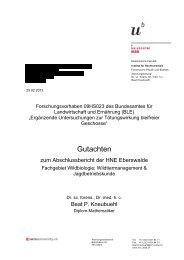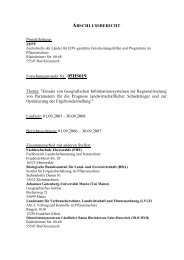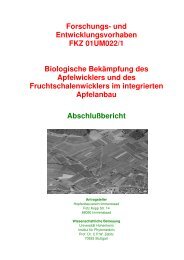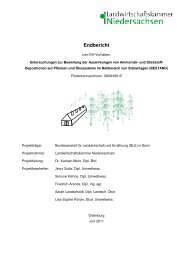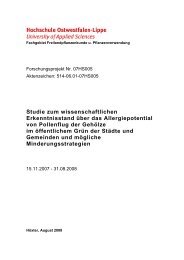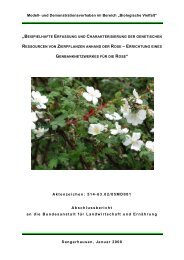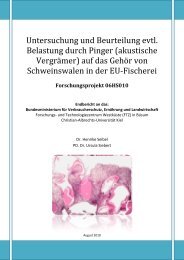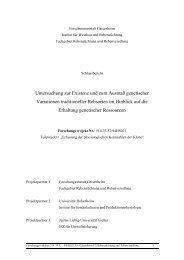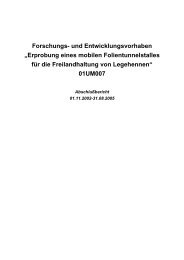Abschlussbericht Projekt: „Verminderung der ... - BLE
Abschlussbericht Projekt: „Verminderung der ... - BLE
Abschlussbericht Projekt: „Verminderung der ... - BLE
Sie wollen auch ein ePaper? Erhöhen Sie die Reichweite Ihrer Titel.
YUMPU macht aus Druck-PDFs automatisch weboptimierte ePaper, die Google liebt.
of potato tubers (Alvarez et al., 2000a; Bajema et al., 1998a; Lærke, 2001), elasticity and<br />
specific gravity of potato parenchyma (Scanlon et al., 1998) and cold storage and impact<br />
susceptibility of potato tubers (Bajema et al., 1998a, b). However, tissue water status of the<br />
tuber is related to both its water concentration (e.g. water mass or water volume) and the<br />
chemical potential of the water within cells (Galindo et al., 2004b; von Willert et al.,<br />
1995). The latter is commonly described by the actual tissue water potential, which, itself<br />
is determined by the respective osmotic (osmotic potential) and pressure component (pressure<br />
potential or turgor) (Galindo et al., 2004b). Detailed information about the chemical<br />
potential of water and impact susceptibility was given for carrot roots (Herppich et al.,<br />
1999) and for radish tubers (Landahl et al., 2004) and particularly for potato tubers (Lærke,<br />
2001).<br />
The present investigation evaluates the chemical potential of water in potato tubers to provide<br />
detailed measurements of changes in water status through time and to relate these<br />
changes, if any, to blackspot susceptibility of potato tubers. This study is aimed to get a<br />
more exact knowledge about blackspot development and may facilitate to develop optimal<br />
techniques of handling and storage which help to obtain and to maintain the highest possible<br />
product quality for the consumer.<br />
Materials and methods<br />
Material. Eight cultivars of table potatoes (Adretta, Afra, Gala, Granola, Lolita, Marabel,<br />
Nicola and Renate) were grown near Dethlingen (Germany) by conventional farming<br />
methods during two vegetation periods (2006 and 2007). To guarantee comparable results<br />
only tubers with a similar size of 40 to 50 mm were chosen for the experiments. Analyses<br />
were performed directly after harvest and after five and eight months, respectively, of storage<br />
at 4°C and 95 % relative humidity. Prior to investigation tubers were sorted into six<br />
classes of specific gravity from 1.095 kg L -1 , with 0.01 increments, by immersing<br />
them into NaCl-solutions of different concentrations. Then, the tubers of each class<br />
were split into two batches. Tubers of the first batch were used to determine their blackspot<br />
index (BSI), those of the second batch were used to determine water concentration, water<br />
potential, osmolality, osmotic potential, modulus of elasticity and pressure potential in the<br />
stem end and the bud end of tubers, respectively.<br />
Analyses. Blackspot index (BSI) of whole potato tubers of different specific gravities was<br />
determined according to the method propose by the “Bundessortenamt” (BSA, Fe<strong>der</strong>al<br />
Plant Variety Office, Germany). The tubers were cooled down to 4 to 5°C and mechanical<br />
treated for 50 s in a vegetable washing machine with rotating drum (Flott 18 K, Flottwerk<br />
H.J. Dames GmbH & Co. KG, Rotenburg a. d. F., Germany) with three replications. Each<br />
replication consisted of an amount of tubers (Σ tuber ) adequate to a volume of 6 L. Subsequently,<br />
treated tubers were stored at room temperature for 48 hours. For BSI determination<br />
tubers were cut into halves length-wise and one half was evaluated visually using a<br />
scale with four scores of discolouration. The score “No discolouration” indicated the lack<br />
181




